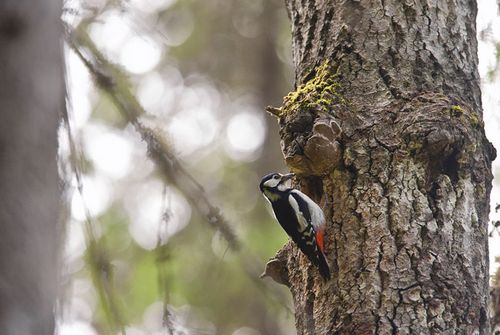Study reveals high density of tree cavities at the Fennoscandian Green Belt
Historically isolated from the western booming economies, many of the constitutive habitats of the European Green Belt could retain their original characteristics in space and time. They therefore offer ideal conditions for rare species to thrive and for scientists to study species-habitat relationships in their evolutionary settings.

In the Fennoscandian section of the European Green Belt, the availability and characteristics of tree cavities as keystone structures for biodiversity were studied in the Russian Kalevala National Park, a 74,000-ha boreal forest landscape representing one of the largest intact natural forest ecosystems in Europe. Carried out over two consecutive research expeditions in September 2018 and August 2019, the survey revealed a density of 8 cavity trees and 20 cavities per ha within an 8-ha study area, a remarkable quantity in comparison with other unmanaged forests of similar tree species composition and climate. In particular, the number of trees with woodpecker cavities was especially high, reaching almost 6 trees per ha and totalizing 14 woodpecker cavities per ha. Some 89% of woodpecker holes were identified as excavated by the great spotted woodpecker Dendrocopos major and 9% either by the great spotted or the three-toed woodpecker Picoides tridactylus.
Moreover, and despite a reported general tendency for woodpeckers to prefer aspens, some 80% of the excavated cavities were situated in centuries-old pine snags (Finnish: kelos) even if large-diameter aspens were also present with an estimated density of 15 trees per ha. As a result, kelo trees provided a majority (60%) of available cavities. These findings question the validity of classifying the boreal forest as a cavity-poor ecosystem and confirm the keystone value of woodpeckers as main cavity provider at those latitudes. The findings could also provide indication that the widespread use of aspens by woodpeckers for excavating their cavities would be a recent phenomenon subsequent to the historical demise by harvesting of better-suited kelo trees that once were plentiful in European forests. Considering the Kalevala National Park a reference forest ecosystem in the Eurasian Taiga, it is proposed that the measured tree cavity availability could be used as a baseline for future habitat restoration guidelines in the boreal vegetation zone.
The results will be presented at the 30-year anniversary conference of the trans-boundary Finnish-Russian Friendship Nature Reserve, that shall be held in Finnish Kuhmo in 2021. The current project was part of the framework project called Finnish–Russian scientific cooperation within the international Friendship Nature Reserve and between Kalevala Parks. It was funded by the Finnish Ministry of the Environment and implemented by the Finnish Environment Institute (SYKE, project leader Gergely Várkonyi) in close cooperation with Sergey Tarkhov, the Director of the Kalevala National Park and of the Kostomuksha Strict Nature Reserve, Russia. All of them together with the staff at the Kalevala National Park are kindly acknowledged for effectively supporting cross-border research cooperation within the Fennoscandian Green Belt.
For more information please contact Philippe Fayt (School of Forest Sciences, University of Eastern Finland).
